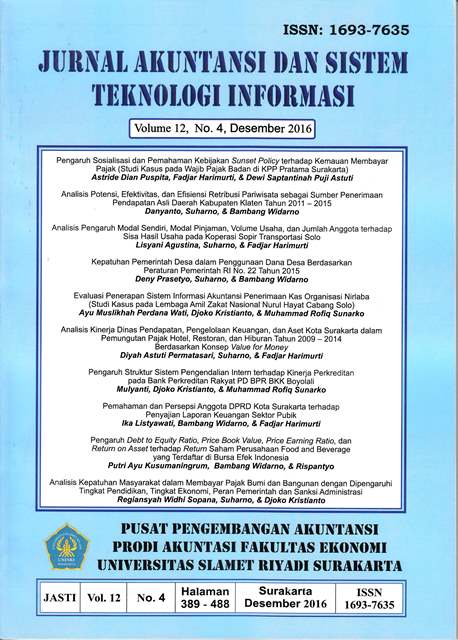EVALUASI PENERAPAN SISTEM INFORMASI AKUNTANSI PENERIMAAN KAS ORGANISASI NIRLABA (Studi Kasus pada Lembaga Amil Zakat Nasional Nurul Hayat Cabang Solo)
Abstract
The purpose of this study were: 1) to analyze the application of cash receipts accounting information systems used at the Institute for National Zakat (LAZNAS) Nurul Hayat Solo. 2) analyze the application of accounting information systems on a cash receipts LAZNAS Nurul Hayat Solo are in accordance with Statement of Financial Accounting Standards (SFAS) No. 109. The method using the case study method, the type of data used quantitative and qualitative data. Data collection methods used documentation, observation and interviews. Data analysis technique used is descriptive qualitative analysis. Based on the results of research and discussion, the researchers conclude that LAZNAS Nurul Hayat Solo in applying accounting information system of cash receipts are in accordance with Statement of Financial Accounting Standards (SFAS) No. 109. This is indicated by: 1) In the process of acceptance and distribution of zakat funds and funds donation / charity LAZNAS Nurul Hayat Solo recorded as increase and decrease during the zakat zakat funds received and expended. 2) LAZNAS Nurul Hayat Solo in preparing the present keuangnnya every transaction separately based on the source and uses. 3) Overall financial reports LAZNAS Nurul Hayat Solo in accordance with SFAS No. 109 of the recognition and measurement as well as the overall presentation uan in accordance with the provisions of SFAS No. 109.
Keywords: Accounting Information Systems, Cash Receipts, Nonprofits
Downloads
Published
Issue
Section
License
Authors who publish this journal agree to the following terms:
- Authors retain copyright and grant the journal right of first publication with the work simultaneously licensed under a Creative Commons Attribution License that allows others to share the work with an acknowledgement of the work's authorship and initial publication in this journal.
- Authors can separately make additional contractual arrangements for non-exclusive distribution published by the journal (e.g., publish it in a book), with an acknowledgement of its initial publication in this journal.
- Authors are allowed and encouraged to send their work via online (e.g., in the institutional repositories or their website) after published by the journal.










